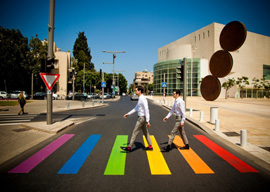
February 13, 2013

Since the 1950s a multitude of solutions to revitalize decaying inner cities have come and gone. If anything, matters have grown worse”brave souls should visit Detroit, Cleveland, Gary, East St. Louis, Memphis, and countless others to see for themselves.
The repertoire of solutions appears exhausted. Big cities have favored massive urban renewal schemes in which whole neighborhoods were destroyed and replaced with award-winning expensive failures such as Detroit’s Renaissance Center. Conservatives continue to embrace tax breaks and similar fiscal incentives, though these seldom performed as advertised.
The root cause of past and continuing failures at breathing life into a dead downtown is simple. The wannabe Doctors of City Health all suffer from what might be called an Edifice Complex. They see urban vitality in terms of concrete things. Signs of “health” mean five-story parking garages, professional landscaping, a large expensive controversial sculpture or fountains, a state-of-the-art multipurpose transportation hub, a modern flexible convention facility with connecting luxury hotel, and modern office buildings galore filled with well-paid white-collar and executive workers.
Those afflicted with this Edifice Complex embrace Say’s Law, i.e., supply creates demand. The construction of parking spaces, for example, will motivate people to drive downtown to fill them. Build a first-class hotel and convention center, and the conventioneers will come. It’s sort of a Chamber of Commerce version of Field of Dreams.
The secret of downtown revival lies in achieving a critical mass of people; repopulation, so to speak. But it is also true that just any sort of people will not do in a proper urban revitalization. If it were simply a matter of numbers, free food and booze plus an occasional wet T-shirt contest would suffice. Nor would homeless and winos qualify. Success requires attracting well-off, law-abiding people willing to spend lavishly.
The sudden arrival of, say, 30,000 people with substantial disposable incomes could easily revitalize even such dreary places as Trenton, NJ. Such recruits could eliminate urban blight without any of the usual expensive edifices and tax concessions. Within a few years, the locals would be complaining of too much economic activity, lack of cheap retail space, and long waits to eat and drink.
How does one, then, attract these precious folk? The answer is simple, though hardly straightforward. Import thousands of gays to any downtown”no matter how bleak and uninviting”and within a year or two the result will be a real-estate developer’s dream. Gays”not tax abatements, convention centers, malls, office buildings, or all the usual nostrums”are the only solution guaranteed to uplift struggling cities.
If one is not convinced of the utility of this approach, just visit Key West, New York City’s West Village, Miami Beach’s South Beach, Chicago’s “Boystown,” several neighborhoods in San Francisco, or any other locality where gays congregate in sizable numbers. The current revitalization of Washington, DC owes much to the gay influx, though this is seldom admitted publicly. Put it this way: Is there any known gay community characterized by slum conditions and economic misery? The presence of gays is the best urban economic fix known to man.
Consider some obvious facts. Yes, many gays are not especially wealthy, but their disposable income is considerable, even among those with modest wages. Unlike straights, gays do not have the long-term family obligations that inhibit indulging in trendy clothing or the latest theatrical offering. They seldom have children needing a nanny or daycare. Money need not be put aside for a future expensive college education or inheritance. Take-home pay can be immediately and entirely spent. Every gay enclave that I visited or know about thrives economically.
Equally important, a gay population is cheap to maintain. The largest drain on the municipal budget is education, and since most gays are childless, this expenditure can be reduced substantially”fewer schools, teachers, school buses, and expensive special programs. In addition, compared to the law-enforcement problems straight males create, gays require minimal policing. An occasional loud party or overcrowded bar, yes; muggings, robberies, gang fights, big-time drug dealings, no. It is not that gays are perfectly law-abiding; it is that their misbehavior does not demand the expensive police effort common in troubled cities. Nor do gays tend to avail themselves of public welfare.
Gays also contribute handsomely to the revenue side. They are famous for fixing up decrepit property. Whereas Washington will spend tens of millions destroying fine old but somewhat rundown neighborhoods to construct ugly, crime-ridden, Soviet-style housing projects, gays with a few thousand of their own money will convert dilapidated homes to architectural jewels. At no cost to the taxpayer, the city’s tax base is doubled or even tripled!